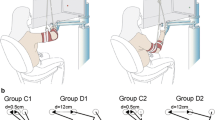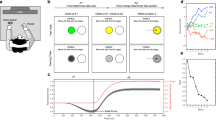Abstract
In recent studies of human motor learning, subjects learned to move the arm while grasping a robotic device that applied novel patterns of forces to the hand. Here, we examined the generality of force field learning. We tested the idea that contextual cues associated with grasping a novel object promote the acquisition and use of a distinct internal model, associated with that object. Subjects learned to produce point-to-point arm movements to targets in a horizontal plane while grasping a robotic linkage that applied either a velocity-dependent counter-clockwise or clockwise force field to the hand. Following adaptation, subjects let go of the robot and were asked to generate the same movements in free space. Small but reliable after-effects were observed during the first eight movements in free space, however, these after-effects were significantly smaller than those observed for control subjects who moved the robot in a null field. No reduction in retention was observed when subjects subsequently returned to the force field after moving in free space. In contrast, controls who reached with the robot in a NF showed much poorer retention when returning to a force field. These findings are consistent with the idea that contextual cues associated with grasping a novel object may promote the acquisition of a distinct internal model of the dynamics of the object, separate from internal models used to control limb dynamics alone.



Similar content being viewed by others
References
Bays PM, Flanagan JR, Wolpert DM (2005) Interference between velocity-dependent and position-dependent force-fields indicates that tasks depending on different kinematic parameters compete for motor working memory. Exp Brain Res 163:400–405
Conditt MA, Mussa-Ivaldi FA (1999) Central representation of time during motor learning. Proc Natl Acad Sci USA 96:11625–11630
Conditt MA, Gandolfo F, Mussa-Ivaldi FA (1997) The motor system does not learn the dynamics of the arm by rote memorization of past experience. J Neurophysiol 78:554–560
Davidson PR, Wolpert DM (2004) Internal models underlying grasp can be additively combined. Exp Brain Res 155:334–340
Davidson PR, Wolpert DM, Scott SH, Flanagan JR (2005) Common encoding of novel dynamic loads applied to the hand and arm. J Neurosci 25:5425–5429
Debicki DB, Gribble PL (2004) Inter-joint coupling strategy during adaptation to novel viscous loads in human arm movement. J Neurophysiol 92:754–765
Debicki DB, Gribble PL (2005) Persistence of inter-joint coupling during single-joint elbow flexions after shoulder fixation. Exp Brain Res 163:252–257
Flanagan JR, Wing AM (1997) The role of internal models in motion planning and control: evidence from grip force adjustments during movements of hand-held loads. J Neurosci 17:1519–1528
Gandolfo F, Mussa-Ivaldi FA, Bizzi E (1996) Motor learning by field approximation. Proc Natl Acad Sci USA 93:3843–3846
Gandolfo F, Li C, Benda BJ, Schioppa CP, Bizzi E (2000) Cortical correlates of learning in monkeys adapting to a new dynamical environment. Proc Natl Acad Sci USA 97:2259–2263
Gribble PL, Scott SH (2002) Overlap of internal models in motor cortex for mechanical loads during reaching. Nature 417:938–941
Haruno M, Wolpert DM, Kawato M (2001) Mosaic model for sensorimotor learning and control. Neural Comput 13:2201–2220
Karniel A, Mussa-Ivaldi FA (2002) Does the motor control system use multiple models and context switching to cope with a variable environment? Exp Brain Res 143:520–524
Kawato M (1999) Internal models for motor control and trajectory planning. Curr Opin Neurobiol 9:718–727
Koshland GF, Galloway JC, Nevoret-Bell CJ (2000) Control of the wrist in three-joint arm movements to multiple directions in the horizontal plane. J Neurophysiol 83:3188–3195
Krouchev NI, Kalaska JF (2003) Context-dependent anticipation of different task dynamics: rapid recall of appropriate motor skills using visual cues. J Neurophysiol 89:1165–1175
Lackner JR, Dizio P (1994) Rapid adaptation to Coriolis force perturbations of arm trajectory. J Neurophysiol 72:299–313
Malfait N, Gribble PL, Ostry DJ (2005) Generalization of motor learning based on multiple field exposures and local adaptation. J Neurophysiol 93:3327–3338
Mattar AA, Gribble PL (2005) Motor learning by observing. Neuron 46:153–160
Mattar AAG, Ostry DJ (2005) Motor learning as a running average of past experience. In: Society for Neuroscience Abstracts Program No. 181.5. Society for Neuroscience, Washington, DC
Osu R, Hirai S, Yoshioka T, Kawato M (2004) Random presentation enables subjects to adapt to two opposing forces on the hand. Nat Neurosci 7:111–112
Sainburg RL, Ghez C, Kalakanis D (1999) Intersegmental dynamics are controlled by sequential anticipatory, error correction, and postural mechanisms. J Neurophysiol 81:1045–1056
Shadmehr R, Brashers-Krug T (1997) Functional stages in the formation of human long-term motor memory. J Neurosci 17:409–419
Shadmehr R, Mussa-Ivaldi FA (1994) Adaptive representation of dynamics during learning of a motor task. J Neurosci 14:3208–3224
Shadmehr R, Brandt J, Corkin S (1998) Time-dependent motor memory processes in amnesic subjects. J Neurophysiol 80:1590–1597
Thoroughman KA, Shadmehr R (1999) Electromyographic correlates of learning an internal model of reaching movements. J Neurosci 19:8573–8588
Wolpert DM, Flanagan JR (2001) Motor prediction. Curr Biol 11:R729–R732
Acknowledgements
The authors wish to thank N. Malfait, A. Mattar and D. Ostry for helpful comments. This Research was supported by CIHR (Canada).
Author information
Authors and Affiliations
Corresponding author
Rights and permissions
About this article
Cite this article
Cothros, N., Wong, J.D. & Gribble, P.L. Are there distinct neural representations of object and limb dynamics?. Exp Brain Res 173, 689–697 (2006). https://doi.org/10.1007/s00221-006-0411-0
Received:
Accepted:
Published:
Issue Date:
DOI: https://doi.org/10.1007/s00221-006-0411-0




